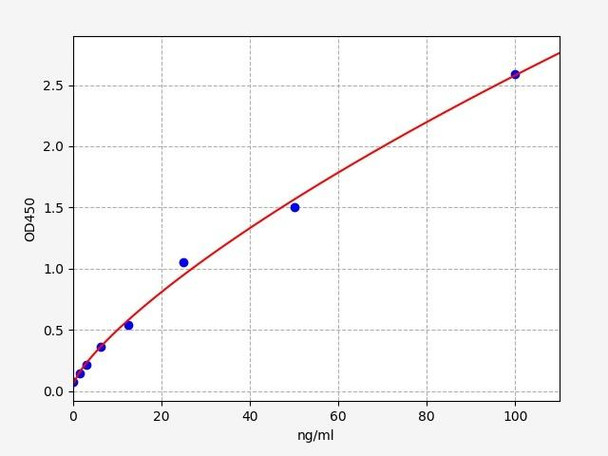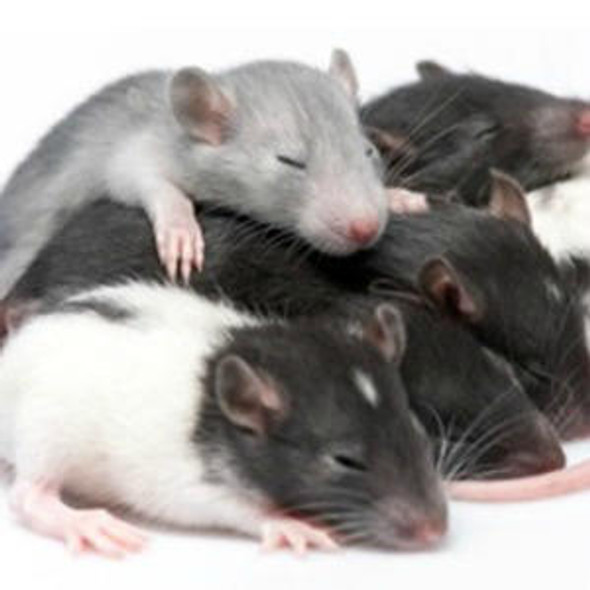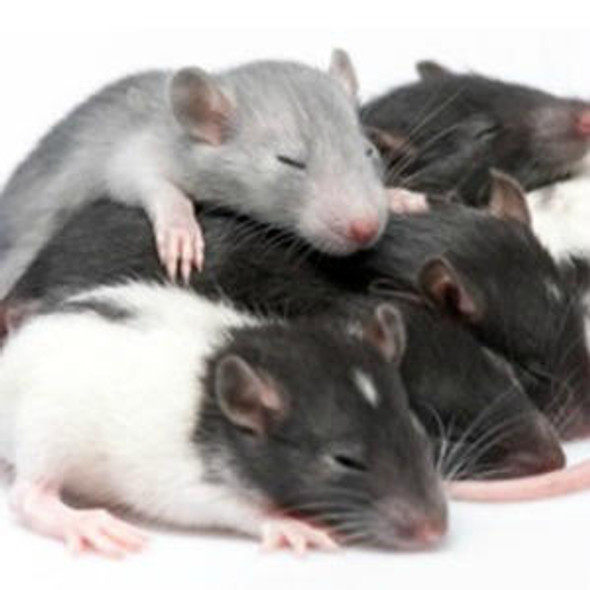Rat Serpin A8 / Angiotensinogen ELISA Kit
- SKU:
- RTFI00247
- Product Type:
- ELISA Kit
- Size:
- 96 Assays
- Uniprot:
- P01015
- Sensitivity:
- 0.938ng/ml
- Range:
- 1.563-100ng/ml
- ELISA Type:
- Sandwich ELISA, Double Antibody
- Synonyms:
- Agt, AGT, Angiotensin II, Angiotensinogen, Aogen, PAT, alpha-1 antiproteinase, antitrypsin, angiotensin II, angiotensinogen, angiotensinogen, serpin peptidase inhibitor, clade A, member 8, ANHU, FLJ92595, FLJ97926, pre-angiotensinogen, serine, or cys
- Reactivity:
- Rat
Description
| Product Name: | Rat Agt (Angiotensinogen) ELISA Kit |
| Product Code: | RTFI00247 |
| Size: | 96 Assays |
| Target: | Rat Agt |
| Alias: | Agt, AGT, Angiotensin II, Angiotensinogen, Aogen, PAT, alpha-1 antiproteinase, antitrypsin, angiotensin II, angiotensinogen, angiotensinogen, serpin peptidase inhibitor, clade A, member 8, ANHU, FLJ92595, FLJ97926, pre-angiotensinogen, serine, or cysteine proteinase inhibitor, Serpin A8, SERPINA8angiotensin I |
| Reactivity: | Rat |
| Detection Method: | Sandwich ELISA, Double Antibody |
| Sensitivity: | 0.938ng/ml |
| Range: | 1.563-100ng/ml |
| Storage: | 4°C for 6 months |
| Note: | For Research Use Only |
| Recovery: | Matrices listed below were spiked with certain level of Rat Agt and the recovery rates were calculated by comparing the measured value to the expected amount of Rat Agt in samples. | ||||||||||||||||
| |||||||||||||||||
| Linearity: | The linearity of the kit was assayed by testing samples spiked with appropriate concentration of Rat Agt and their serial dilutions. The results were demonstrated by the percentage of calculated concentration to the expected. | ||||||||||||||||
| |||||||||||||||||
| Intra-Assay: | CV <8% | ||||||||||||||||
| Inter-Assay: | CV <10% |
| Uniprot: | P01015 |
| UniProt Protein Function: | angiotensin: Essential component of the renin-angiotensin system (RAS), a potent regulator of blood pressure, body fluid and electrolyte homeostasis. In response to lowered blood pressure, the enzyme renin cleaves angiotensinogen to produce angiotensin-1 (angiotensin 1-10). Angiotensin-1 is a substrate of ACE (angiotensin converting enzyme) that removes a dipeptide to yield the physiologically active peptide angiotensin-2 (angiotensin 1- 8). Angiotensin-1 and angiotensin-2 can be further processed to generate angiotensin-3 (angiotensin 2-8), angiotensin-4 (angiotensin 3-8). Angiotensin 1-7 is cleaved from angiotensin-2 by ACE2 or from angiotensin-1 by MME (neprilysin). Angiotensin 1-9 is cleaved from angiotensin-1 by ACE2. Genetic variations in AGT are a cause of susceptibility to essential hypertension (EHT). Essential hypertension is a condition in which blood pressure is consistently higher than normal with no identifiable cause. Defects in AGT are a cause of renal tubular dysgenesis (RTD). RTD is an autosomal recessive severe disorder of renal tubular development characterized by persistent fetal anuria and perinatal death, probably due to pulmonary hypoplasia from early-onset oligohydramnios (the Potter phenotype). Belongs to the serpin family. |
| UniProt Protein Details: | Protein type:Secreted, signal peptide; Secreted Chromosomal Location of Human Ortholog: 1q42.2 Cellular Component: extracellular space; cytoplasm; extracellular region Molecular Function:serine-type endopeptidase inhibitor activity; protein binding; growth factor activity; sodium channel regulator activity; hormone activity; type 2 angiotensin receptor binding; superoxide-generating NADPH oxidase activator activity; type 1 angiotensin receptor binding Biological Process: renal system process; extracellular matrix organization and biogenesis; positive regulation of nitric oxide biosynthetic process; establishment of blood-nerve barrier; negative regulation of nerve growth factor receptor signaling pathway; positive regulation of transcription, DNA-dependent; stress-activated MAPK cascade; female pregnancy; positive regulation of multicellular organism growth; positive regulation of vasodilation; activation of NF-kappaB transcription factor; ovarian follicle rupture; positive regulation of fibroblast proliferation; cell-cell signaling; positive regulation of superoxide release; negative regulation of neuron apoptosis; kidney development; positive regulation of NAD(P)H oxidase activity; positive regulation of cytokine production; angiotensin mediated regulation of renal output; response to muscle activity involved in regulation of muscle adaptation; regulation of calcium ion transport; regulation of norepinephrine secretion; negative regulation of tissue remodeling; positive regulation of phosphoinositide 3-kinase cascade; positive regulation of peptidyl-tyrosine phosphorylation; phospholipase C activation; angiotensin mediated vasoconstriction involved in regulation of systemic arterial blood pressure; regulation of vasoconstriction; regulation of transmission of nerve impulse; G-protein signaling, coupled to IP3 second messenger (phospholipase C activating); smooth muscle cell differentiation; cytokine secretion; nitric oxide mediated signal transduction; regulation of long-term neuronal synaptic plasticity; peristalsis; cell-matrix adhesion; renin-angiotensin regulation of aldosterone production; positive regulation of cellular protein metabolic process; smooth muscle cell proliferation; cellular lipid metabolic process; excretion; angiotensin maturation; vasodilation; response to salt stress; negative regulation of cell proliferation; positive regulation of MAPKKK cascade; fibroblast proliferation; renin-angiotensin regulation of blood vessel size; regulation of blood pressure; positive regulation of epidermal growth factor receptor signaling pathway; renin-angiotensin regulation of blood volume; regulation of cell growth; angiotensin mediated drinking behavior; artery smooth muscle contraction; aging; positive regulation of fatty acid biosynthetic process; blood vessel development; cellular sodium ion homeostasis; renal response to blood flow during renin-angiotensin regulation of systemic arterial blood pressure; activation of NF-kappaB-inducing kinase; positive regulation of peptidyl-serine phosphorylation; positive regulation of organ growth; regulation of cell proliferation; G-protein coupled receptor protein signaling pathway; negative regulation of angiogenesis; cellular protein metabolic process; ureteric bud branching; G-protein signaling, coupled to cGMP nucleotide second messenger; blood vessel remodeling; negative regulation of cell growth; response to cold; astrocyte activation; positive regulation of inflammatory response Disease: Renal Tubular Dysgenesis; Hypertension, Essential |
| NCBI Summary: | plays a role in regulation of blood pressure [RGD, Feb 2006] |
| UniProt Code: | P01015 |
| NCBI GenInfo Identifier: | 19705570 |
| NCBI Gene ID: | 24179 |
| NCBI Accession: | NP_602308.1 |
| UniProt Secondary Accession: | P01015,Q16358, Q16359, Q96F91, |
| UniProt Related Accession: | P01015 |
| Molecular Weight: | ~61-65,000 |
| NCBI Full Name: | angiotensinogen |
| NCBI Synonym Full Names: | angiotensinogen (serpin peptidase inhibitor, clade A, member 8) |
| NCBI Official Symbol: | Agt |
| NCBI Official Synonym Symbols: | Ang; PAT; ANRT; AngII |
| NCBI Protein Information: | angiotensinogen; serpin A8; angiotensin II; angiotensinogen (PAT) |
| UniProt Protein Name: | Angiotensinogen |
| UniProt Synonym Protein Names: | Serpin A8Cleaved into the following 8 chains:Angiotensin-1Alternative name(s):Angiotensin 1-10; Angiotensin I; Ang I |
| Protein Family: | Angiotensinogen |
| UniProt Gene Name: | AGT |
| UniProt Entry Name: | ANGT_HUMAN |
| Step | Procedure |
| 1. | Set standard, test sample and control (zero) wells on the pre-coated plate respectively, and then, record their positions. It is recommended to measure each standard and sample in duplicate. Wash plate 2 times before adding standard, sample and control (zero) wells! |
| 2. | Aliquot 0.1ml standard solutions into the standard wells. |
| 3. | Add 0.1 ml of Sample / Standard dilution buffer into the control (zero) well. |
| 4. | Add 0.1 ml of properly diluted sample ( Human serum, plasma, tissue homogenates and other biological fluids.) into test sample wells. |
| 5. | Seal the plate with a cover and incubate at 37°C for 90 min. |
| 6. | Remove the cover and discard the plate content, clap the plate on the absorbent filter papers or other absorbent material. Do NOT let the wells completely dry at any time. Wash plate X2. |
| 7. | Add 0.1 ml of Biotin- detection antibody working solution into the above wells (standard, test sample & zero wells). Add the solution at the bottom of each well without touching the side wall. |
| 8. | Seal the plate with a cover and incubate at 37°C for 60 min. |
| 9. | Remove the cover, and wash plate 3 times with Wash buffer. Let wash buffer rest in wells for 1 min between each wash. |
| 10. | Add 0.1 ml of SABC working solution into each well, cover the plate and incubate at 37°C for 30 min. |
| 11. | Remove the cover and wash plate 5 times with Wash buffer, and each time let the wash buffer stay in the wells for 1-2 min. |
| 12. | Add 90 µL of TMB substrate into each well, cover the plate and incubate at 37°C in dark within 10-20 min. (Note: This incubation time is for reference use only, the optimal time should be determined by end user.) And the shades of blue can be seen in the first 3-4 wells (with most concentrated standard solutions), the other wells show no obvious color. |
| 13. | Add 50 µL of Stop solution into each well and mix thoroughly. The color changes into yellow immediately. |
| 14. | Read the O.D. absorbance at 450 nm in a microplate reader immediately after adding the stop solution. |
When carrying out an ELISA assay it is important to prepare your samples in order to achieve the best possible results. Below we have a list of procedures for the preparation of samples for different sample types.
| Sample Type | Protocol |
| Serum: | If using serum separator tubes, allow samples to clot for 30 minutes at room temperature. Centrifuge for 10 minutes at 1,000x g. Collect the serum fraction and assay promptly or aliquot and store the samples at -80°C. Avoid multiple freeze-thaw cycles. If serum separator tubes are not being used, allow samples to clotovernight at 2-8°C. Centrifuge for 10 minutes at 1,000x g. Removeserum and assay promptly or aliquot and store the samples at-80°C. Avoid multiple freeze-thaw cycles. |
| Plasma: | Collect plasma using EDTA or heparin as an anti-coagulant. Centrifuge samples at 4°C for 15 mins at 1000 — g within 30 mins of collection. Collect the plasma fraction and assay promptly or aliquot and store the samples at -80°C. Avoid multiple freeze-thaw cycles.Note: Over haemolysed samples are not suitable for use with this kit. |
| Urine & Cerebrospinal Fluid: | Collect the urine (mid-stream) in a sterile container, centrifuge for 20 mins at 2000-3000 rpm. Remove supernatant and assay immediately. If any precipitation is detected, repeat the centrifugation step. A similar protocol can be used for cerebrospinal fluid. |
| Cell Culture Supernatant: | Collect the cell culture media by pipette, followed by centrifugation at 4°C for 20 mins at 1500 rpm. Collect the clear supernatant and assay immediately. |
| Cell Lysates: | Solubilize cells in lysis buffer and allow to sit on ice for 30 minutes. Centrifuge tubes at 14,000 x g for 5 minutes to remove insoluble material. Aliquot the supernatant into a new tube and discard the remaining whole cell extract. Quantify total protein concentration using a total protein assay. Assay immediately or aliquot and store at ≤ -20°C. |
| Tissue Homogenates: | The preparation of tissue homogenates will vary depending upon tissue type. Rinse tissue with 1X PBS to remove excess blood & homogenizein 20ml of 1X PBS (including protease inhibitors) and store overnight at ≤ -20°C. Two freeze-thaw cycles are required to break the cell membranes. To further disrupt the cell membranes you can sonicate the samples. Centrifuge homogenates for 5 mins at 5000xg. Remove the supernatant and assay immediately or aliquot and store at -20°C or-80°C. |
| Tissue Lysates: | Rinse tissue with PBS, cut into 1-2 mm pieces, and homogenize with a tissue homogenizer in PBS. Add an equal volume of RIPA buffer containing protease inhibitors and lyse tissues at room temperature for 30 minutes with gentle agitation. Centrifuge to remove debris. Quantify total protein concentration using a total protein assay. Assay immediately or aliquot and store at ≤ -20 °C. |
| Breast Milk: | Collect milk samples and centrifuge at 10,000 x g for 60 min at 4°C. Aliquot the supernatant and assay. For long term use, store samples at -80°C. Minimize freeze/thaw cycles. |










